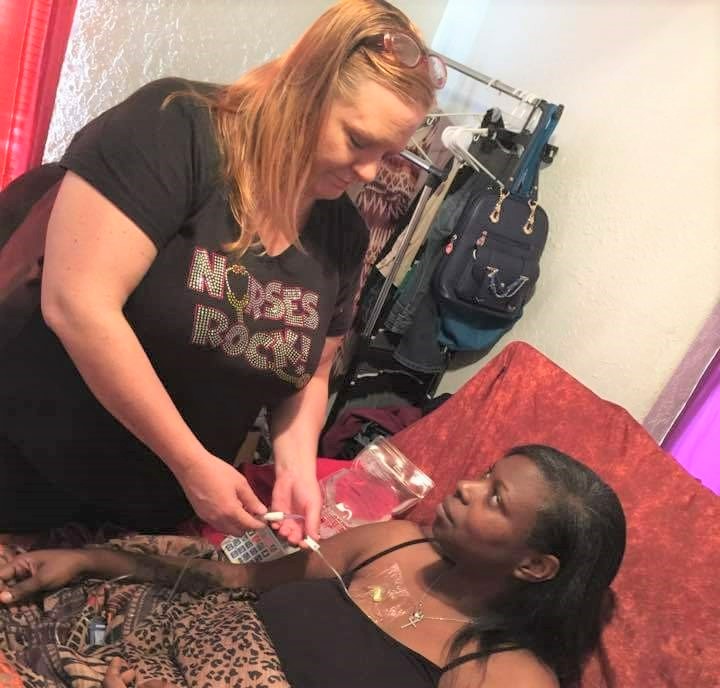As with most medications, immune globulin (IG) therapy can cause side effects. If your IG infusion leaves you with these uncomfortable symptoms, the good news is most of the time there are things you, your nurse, or the prescriber can do to make side effects less likely and relieve them if they happen.
Infusion reactions are most common if you use intravenous immune globulin (IVIG) rather than the subcutaneous form (SCIG). IG infusion nurses and pharmacists are usually very familiar with the types of reactions that can occur during or after your infusion, and they know how to respond to them. Rest assured that your nurse will be with you throughout your infusion to monitor for any reactions and respond to them.
Premedication can be one way to avoid reactions from occuring. Along with IG infusions, prescribers often prescribe over-the-counter pain medications, such as acetaminophen (Tylenol) or ibuprofen (Advil), and an antihistamine such as diphenhydramine (Benadryl).
Drinking lots of fluids (several liters a day) before, during, and after the infusion will also help. Be sure to hydrate with water not soda, coffee, milk, or other beverages.
Common Symptoms
Headache is one of the most common side effects with IVIG therapy, but usually this is mild. It’s why the nurse will start out running the infusion slowly and increase the rate gradually over the first hour or so. If a headache develops, the nurse will likely run the infusion more slowly to see if this will relieve the pain. Drinking more fluids may also help. If the infusion needs to run so slowly that it will take all day to infuse, it may need to be divided into smaller doses and given over several days.
Other milder symptoms may also occur—with or without a headache—including chills, fever, flushing, dizziness, muscle aches, joint pain, fatigue, nausea and/or vomiting, and rash. If these symptoms are significant, your prescriber may decide to try a different brand of IG. Each brand is slightly different in composition, and some people do better with one brand over another. Your nurse will consult with the pharmacist and/or your prescriber to decide how to best manage your symptoms.
For subcutaneous infusions (SCIG), pain, redness, and swelling at the needle site may also occur. Be sure to let your nurse know if you notice this and if it gets worse during the infusion. One possible solution may be to change or reposition the infusion needle.
If you use SCIG, you may notice lumps under your skin at the infusion site. This is expected and happens because the fluid you are infusing takes some time to be absorbed into your body. If these areas become uncomfortable, you can apply a warm cloth or compress to the area. If they last for more than a day or are painful, call your nurse or pharmacist.
More Serious Adverse Reactions
While headache is a common reaction with IG infusions, it usually goes away during or soon after the infusion, especially if treated with pain medication and hydration.
If your headache continues for days, is especially severe, or you have a stiff neck, drowsiness, high fever, sensitivity to light, eye pain, or severe nausea or vomiting, this is a cause for alarm. These may be signs of a rare reaction called aseptic meningitis (swelling of the brain not caused by infection). You should call your prescriber and the pharmacy and get medical help right away.
Another rare but serious situation is an allergic reaction (anaphylaxis). This usually happens during the infusion while the nurse is with you. If you get your infusions at home, your shipment from the pharmacy will also include medications the nurse can use to treat this reaction.
You may notice symptoms of an allergic reaction after the infusion is completed and the nurse has left. Such symptoms may include rash, itching or swelling (especially of the face, tongue, or throat), severe dizziness, or trouble breathing. If these occur, call 911 and get medical attention as fast as possible.
IG may also raise your blood pressure. Your nurse will check this frequently during your infusion. If you have had high blood pressure in the past or are currently being treated for it, please make sure that the prescriber, nurse, and pharmacist are aware. If you check your own pressure, be sure to notify the prescriber if it increases in the days following your infusion.
Other Possible Concerns
IG is made from human blood plasma, so it can rarely cause blood clots. This is more likely in older adults or those who previously have had blood clots, heart problems, or blood circulation problems. Blood clots are also more likely if you have been on bedrest for a long time, are using birth control pills or hormone replacement therapy, or if you have a central intravenous (IV) catheter in place.
Call your prescriber and pharmacist immediately if you have chest pain, trouble breathing, chest tightness, or rapid heartbeats. Other signs of a blood clot can be numbness or weakness, swelling and warmth, or discoloration in an arm or leg.
You should also let your prescriber and pharmacist know right away if you notice that your gums or nose start bleeding, you bruise more easily, it takes a long time to stop a cut from bleeding, you have a fainting spell, you feel like your heart is racing or skipping beats, or you feel unusually tired. These are signs of other cardiovascular problems that may need to be treated.
Sometimes IG can harm your kidneys, especially if you have kidney disease or use certain medicines. Signs of kidney problems include swelling, especially in the legs and hands, rapid weight gain, and little or no urination. Call your prescriber and pharmacy right away if you notice any of these symptoms.
Less of a Concern
Because IG is made with donated human plasma, some people worry about getting a disease from it. The risk of getting an infection from your treatment, however, is almost nonexistent. Modern methods used to purify IG destroy bacteria, hepatitis viruses, and other infectious germs. No one can predict every new infection that may develop, though. This is one of the reasons the pharmacy keeps careful records of the specific IG product you receive.
It’s also important that you keep track of when you get your infusions, the brand, product number, lot number, and any reactions you have around the time of the infusion. This will help you determine which products worked best and can help the pharmacist figure out if you are having side effects related to a specific brand.
Please Ask Questions
Never be afraid to ask questions about any symptom or reaction you have during or after your treatment. Your infusion nurse, pharmacist, and prescriber can all help you understand any reactions you may experience and how to treat them.
Please remember: Every patient is unique in the way they respond to any treatment. Do not hesitate to let your nurse or pharmacist know if you start to notice uncomfortable side effects. Lastly, if you ever experience unusual symptoms that cause you concern, be sure to contact your prescriber immediately.



